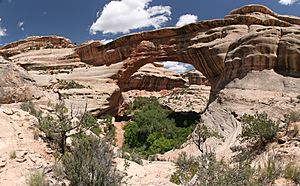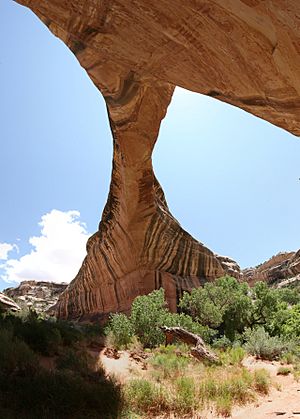Sipapu Bridge facts for kids
Sipapu Bridge is an amazing natural rock formation. It is found in Natural Bridges National Monument in central Utah, United States. This giant stone bridge stretches across White Canyon. It is a beautiful example of how nature can create incredible structures over time.
Contents
What is Sipapu Bridge?
Sipapu Bridge is a type of natural arch. These are rock formations shaped like an arch or a bridge. They are formed when wind and water slowly wear away softer rock. Sipapu Bridge is one of the most famous natural bridges in the world. It is a popular spot for visitors to explore.
How Big is Sipapu Bridge?
For a long time, people thought Sipapu Bridge was 268 feet (82 m) long. This measurement came from the National Park Service. It made Sipapu the fourth longest natural arch in the world.
However, in 2007, scientists used special laser tools to measure it again. They found that the bridge is actually 255 feet (78 m) long. This new measurement means it is the thirteenth longest natural arch.
There is a difference between a "natural arch" and a "natural bridge." Sipapu is considered the sixth longest natural bridge. Other famous natural bridges include Rainbow Bridge in Utah. There are also four longer natural bridges in China.
Exploring Sipapu Bridge
You can see Sipapu Bridge from a special viewing area by the road. But to really experience it, you can hike down to its base. A trail leads from the top of the canyon right down to the bridge.
It is special because you can still walk under Sipapu Bridge. Some other large natural arches, like Landscape Arch, have trails that no longer go underneath them for safety. Also, walking under Rainbow Bridge is not allowed out of respect for Navajo and Hopi spiritual beliefs. This makes Sipapu Bridge the longest natural arch in the world where visitors can still walk right underneath it. This gives you an amazing view of the bridge from below!
What Does "Sipapu" Mean?
The name "Sipapu" comes from the Hopi language. In Hopi culture, a sipapu is a special opening or portal. It is believed to be the place where the first human ancestors came out of the Earth.
The name "Sipapu" was given to the bridge in 1908. Before that, it had other names. Some of these older names included "President," "Augusta," and "Great Augusta." These names were used until the middle of the 20th century.



